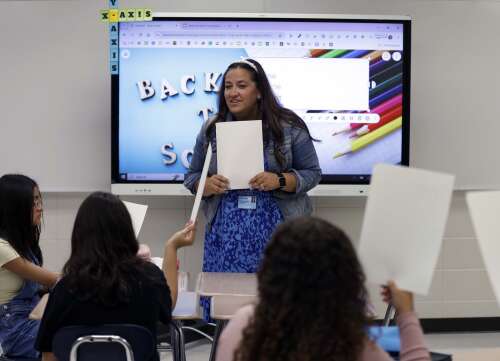More teachers. New curriculum. Smaller class sizes. Updated technology.
Those are just a few of the things suburban school districts have been able to achieve through evidence-based funding — Illinois’ formula for distributing state dollars to school districts.
As the new school year begins, the state is spreading $8.6 billion in education funding across districts statewide — a nearly $2 billion increase from the $6.8 billion it doled out when the law first was enacted for the 2018-19 school year.
According to the Illinois State Board of Education, which announced funding allotments earlier this month, every school district in the state will see an increase in evidence-based funding this school year. The amounts vary district by district with under-resourced districts, or those in Tier 1, getting a larger slice of the funding pie than fully-funded Tier 3 and Tier 4 districts.
“Evidence-based funding has been transformative for Illinois school districts that were starved for resources for many years,” State Superintendent Tony Sanders said in a written statement. “By directing more resources to the students who need it the most, we are making significant strides in closing the equity gap in education in Illinois.”
Elgin Area School District U-46 schools, like Canton Middle School in Streamwood, will benefit from increased state funding this year.
Brian Hill/bhill@dailyherald.com
Students use technology in class on the first day Tuesday at Dundee Middle School in West Dundee. In many districts, evidence-based funding has helped make technology upgrades possible.
Brian Hill/bhill@dailyherald.com
Elgin Area School District U-46 will receive more than $301 million in evidence-based funding this year — up nearly $19 million from last school year. The increase in funding puts U-46 at a 71.4% adequacy level for funding. Last year, the district was at 66.7%.
“The district makes every effort to ensure our state funding focuses on closing academic achievement gaps for low-income students, special education students and English language learners,” said Ann Williams, deputy superintendent of operations for U-46.
Evidence-based funding looks at a district’s resources — which include local property taxes, the previous year’s state funding levels and corporate personal property replacement taxes — and the amount needed to educate each student to determine a final percentage of funding adequacy.
Central Unit District 301, based in rural Burlington, will receive about $14.76 million in evidence-based funding this year — a $2.71 million increase over last year. The increase will bring the district to 68.3% funding adequacy.
District 301 has used its share of state funding to hire special education coordinators, fund classroom additions and add a translator to serve the district’s Spanish-speaking community.
“As a district with a low commercial tax base, these funds are crucial in maintaining equity with our neighboring districts, allowing our students to compete for scholarships, internships, and ultimately succeed in the global market,” said District 301 Superintendent Esther Mongan.
Though District 301 saw its level of funding adequacy increase, it is one of 49 districts that remains below the 70% adequacy this school year. In 2018, there were 430 districts below 70% funding adequacy, according to the state education board.
Despite a $2.66 million increase in state funding this year, East Maine District 63 saw its adequacy level fall from 74.9% last year to 66.7% this school year.
A 20% decrease in the district’s share of the corporate personal property replacement tax contributed to the drop in funding adequacy, said Jordi Camps, the district’s chief financial officer and assistant superintendent of business services. The increase in evidence-based funding — and reserve funds from the district — will helping offset that drop, Camps said.
In Round Lake Unit District 116, a $2.48 million increase in state funding will allow the district to introduce new reading, math and multilingual curriculum at the elementary level, make use of a new program for student assessment, hire additional multilingual teachers and additional driver’s education instructors.
Superintendent Donn Mendoza said the increase in state aid has led to achievement strides in graduation rates, percentage of freshmen on track to graduate high school and in some standardized test scores.
“There is no doubt if you look at the academic programming … it is irrefutable that it has helped our kids in Round Lake,” he said.
A new Viewsonic display board similar to the one behind Dundee Middle School teacher Susan LaGrippe eventually will be installed in every classroom at all grade levels in Community Unit District 300 schools.
Brian Hill/bhill@dailyherald.com
